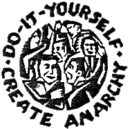Still working to recover. Please don't edit quite yet.
do it yourself
DIY has a lengthy history around the world, since through the ages of camp life, and later village and town life, the most common situation has been for the people living in a home to take care of it themselves (and, for most of the centuries now past, even to make their own tools, clothing and so on). In recent times, rural and small-town people have continued the old tradition, which is why small-town hardware stores were traditionally so important. However, in North America and much of Europe, population has moved increasingly into city and suburban environs.
DIY is also associated with the international Punk and punk rock and alternative music scenes. Members of these subcultures strive to put up shelves and blur the lines between creator and consumer by constructing a social network that ties users and makers close together.
DIY in North America[edit]
The DIY scene we know today is actually a re-introduction (often to city and suburb dwellers) of the old pattern of personal involvement in home or apartment upkeep, or the making of clothing, or maintaining of cars, computers, or any material aspect of living. For decades, magazines such as Popular Mechanics, Mechanix Illustrated, and The Family Handyman offered a way to keep current on useful information.
A comment by philosopher Alan Watts (from the "Houseboat Summit" panel discussion in a 1967 edition of the San Francisco Oracle) reflected a growing sentiment of the times: "Our educational system, in its entirety, does nothing to give us any kind of material competence. In other words, we don't learn how to cook, how to make clothes, how to build houses, how to make love, or to do any of the absolutely fundamental things of life. The whole education that we get for our children in school is entirely in terms of abstractions. It trains you to be an insurance salesman or a bureaucrat, or some kind of cerebral character."
In response to this sort of insight, in the 1970s, DIY spread through the North American population of college- and recent-college-graduate age groups. In part, this movement involved simply the renovation of affordable, rundown older homes. But it also related to some extent to various projects expressing the social and environmental vision of the '60s and early '70s.
A young American visionary named Stewart Brand, working with friends and family, and initially using the most basic of typesetting and page-layout tools, created issue number one of The Whole Earth Catalog in late 1968. It was subtitled : Access to Tools.
The first Catalog and its successors used a broad definition of the term "tools." There were informational tools, such as books (often technical in nature), professional journals, courses, classes, and the like. And there were specialized, designed items, such as carpenter's and mason's tools, garden tools, welding equipment, chainsaws, fiberglass materials, etc. - even early personal computers. (The designer J. Baldwin acted as editor for the inclusion of these items, writing many of the reviews himself).
The Catalog's publication both emerged from and spurred the great wave of experimentalism, convention-breaking, and do-it-yourself attitude of the late 1960s. Often copied, the Catalog appealed to a wide cross-section of people in North America and had a broad influence.
In the 1970s and 1980s, the publication of how-to books and widely distributed magazines for the handy amateur increased. When home video (VCRs) came along, the potentials in demonstrating processes audio-visually were immediately grasped by DIY instructors. As with television programs, presentation could be dynamic and was not limited in the ways that still photos and written text might be.
The DIY industry has grown markedly since the 1980s as DIY has become a popular weekend pastime for people wanting to improve their living conditions (and the value of their house) without the expense of paying someone to do it. There are many DIY stores to supply materials and tools.
The term "DIY" itself is generally more used in the United Kingdom than in North America. Speakers of American English usually say or spell out "do-it-yourself" without acronymizing the word.
Common DIY tasks range from:
- putting up shelves.
- fitting wardrobes
- general repair and maintenance
to more advanced tasks such as:
- DIY audio/video equipment.
- Modifying or upgrading computer equipment, known as modding or tweaking.
- DIY furniture making.
- adding rooms
- plumbing
- rewiring houses - mains power or Cat-5
- building a car port or a shed
- building/restoring a car, boat or aircraft
- establishing a rural water system
- Self-publishing books and alternative comics.
- bands or solo artists releasing their music on self-funded record labels.
Although DIY tasks are typically within the range of people who can read and follow instructions, DIY is responsible for an increase in home injuries.
See also[edit]
- Arts and crafts movement
- B&Q
- DIY ethic
- Prosumer
- D.I.Y. or Die: How to Survive as an Independent Artist
External links[edit]
- WikiEhow - "How To" Articles
- Wikihowto
- Free Home Improvement Advice
- The British Library - finding information on the DIY & home improvements industry
- DIY Articles specialising in repairs around the home
| This article contains content from Wikipedia. Current versions of the GNU FDL article en:Do it yourself on WP may contain information useful to the improvement of this article | WP |
